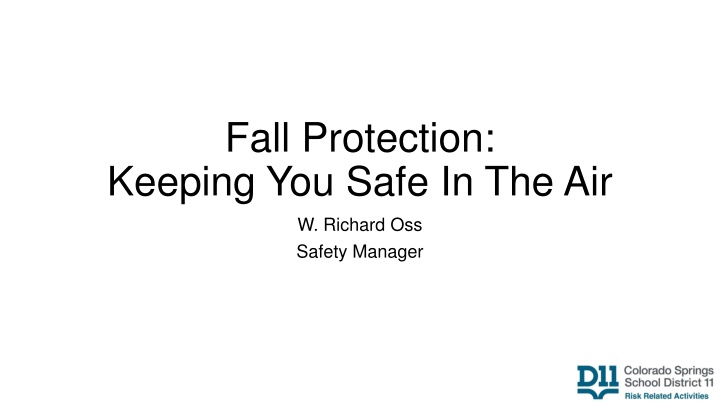
Essential Guide to Fall Protection Systems
Discover the importance of fall protection systems to keep workers safe in elevated environments. Learn about OSHA standards, the components of a personal fall arrest system, the role of the D-ring, calculating forces in falls, lanyards, and anchor points.
Download Presentation

Please find below an Image/Link to download the presentation.
The content on the website is provided AS IS for your information and personal use only. It may not be sold, licensed, or shared on other websites without obtaining consent from the author. If you encounter any issues during the download, it is possible that the publisher has removed the file from their server.
You are allowed to download the files provided on this website for personal or commercial use, subject to the condition that they are used lawfully. All files are the property of their respective owners.
The content on the website is provided AS IS for your information and personal use only. It may not be sold, licensed, or shared on other websites without obtaining consent from the author.
E N D
Presentation Transcript
Fall Protection: Keeping You Safe In The Air W. Richard Oss Safety Manager
Requirements Fall protection is required anytime an employee is up in the air and not enclosed by four rails. OSHA Standards state that any person greater than six feet in the air not fully enclosed must wear fall protection. Any employee who is in the air and not on a ladder and not on a catwalk shall be utilizing fall protection.
The Personal Fall Arrest System There are four parts to the fall arrest system itself. Each element is vitally important to your safety: The D Ring Lanyard Anchor Point Full Body Harness
The D Ring The metal ring is shaped similar to the letter D . This ring is the connection point linking your full body harness to the lanyard. By design, this ring is going to absorb the force of any fall and spread out that force to the entire harness. The ring is designed to withstand 7,000 pounds of force, ONE TIME.
The D Ring Force equals Mass multiplied by Acceleration. (F=M x A) Mass is a fancy term for weight, Acceleration is a fancy term for speed. Acceleration equals the speed of gravity 32.2 feet per second! That means at maximum speed, you re falling 3 stories per second!
Calculating Force Force = Mass x Acceleration (review). So: 200 pound employee Multiplied times the speed of gravity Equals: 6,440 pounds of force in a fall!
Lanyard The lanyard connects the anchorage point to the D ring. Lanyards are available multiple forms, the most common being a retractable lanyard. This type of lanyard acts like a seat belt does in our vehicles. It allows for small movements but will lock in place if it senses any form of quick movement. The lanyard should be fully extended as a part of the inspection process.
Anchor Point The anchor point is the place where the lanyard secures to. This point should always be at or above the employee s working height to maximize its effectiveness. The anchor point must be secure. If the anchor point is not strong enough, it will fail in the event of a fall, and not protect you.
Full Body Harness The harness is the part of the fall protection system that the employee physically wears. Each harness has multiple connection points and can vary with each individual design. If any one of the connection points is not properly secured, it can cause more harm to you than good.
Full Body Harness For example, if a connection point on your left leg is too tight and the right leg is too loose during a fall, the force of the fall will cause your body to jerk to the right in a manner that can twist your back in a violent manner. This can lead to a serious injury! The same can be said if the lower portion of the harness is tighter than the upper portion. All of the force of the fall shifts to the tighter portion of the harness, which doesn t evenly distribute the force. Always make sure all connection points are properly adjusted and secured before ascending in the air.
Effectiveness The harness, lanyard and D ring are all designed to do their job to keep you safe, but unlike us, they only have to work once! Once a fall has occurred, the integrity of the entire fall arrest system has been compromised. Thus, all elements of the system shall be discarded and replaced.
Inspection of the Harness Before equipping the harness, it must be inspected prior to use. Employees should be looking for any defects in the harness such as but not limited to: Cuts Frays Damaged bolts or loop holes Worn or damaged stitches
Training Requirements Fall protection training should be conducted prior to an employee being placed in a position where required to use fall protection. Refresher training should be conducted on an annual basis. Any employee who is going to operate a Sizzor Lift must be trained in the appropriate use of fall protection.
Demonstration Physical Harness Donning Demonstration
